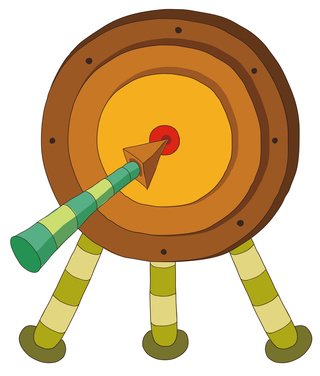
If you want to hit your target, you have to aim.
This column first appeared on RimoftheWorld.net on November 2, 2009.
I was seven years old when I attended Summer Fun Day Camp. And while I enjoyed field trips like swimming and ice skating, I didn’t much take pleasure in our fishing excursion to Cherry Creek. The counselors taught us how to tie tiny bits of raw meat to string, which we cast into murky water in hopes of catching filthy, odd-looking creatures called crawdads. After a few tries, I actually landed one, which I carried home in a big glass jar and kept on top of the refrigerator until it died.
Since that was my introduction to fishing, I have never been much of a fan of the sport. I prefer other hobbies, all of which involve less mud, no raw animal protein and very few freshwater crustaceans.
But I must admit that my crawdad-loving day camp counselors did two things right:
1. They hooked us up with the right bait.
2. They took us to the right place to fish.
As my friend and Action Business Coach Jeff Weston, puts it, “No matter how great your chum or beautifully outfitted your boat, you will never, under any circumstances, catch a shark in Lake Arrowhead, because sharks don’t swim in lakes. They hang out in salt water.”
This is a point I often make with Mountain Marketing Group clients. No matter how professional your logo, slick your brochure or dynamic your website, your advertising efforts will fail if they fail to reach the right target.
- Determining your target isn’t as difficult as it sounds. All you have to do is follow the money.
- If you direct a non-profit, who are your principal donors?
- If you are the CEO of a corporation, which clients buy the largest ticket items, bring repeat business and provide the best referrals?
- If you own a pizza shack, who buys the most pie?
Once you establish the profile of your ideal clients, donors or customers, do some data mining, which means to create profiles of users who will be most receptive to your message. The three steps of data mining include:
Data collecting—information is gathered. (Who is your best customer?)
Data refining— user profiles are compared with recorded behavior to divide the users into groups and to predict their behavior. (Where do they spend their time?)
Data delivery—the business or website answers a user’s question on the fly or sends a targeted online ad to a browser, based on the results in the database. (How can you effectively deliver your message to the intended target?)
These days, no matter what your field, virtually every patron or potential paying customer spends at least some of his or her time somewhere online. So an ideal place to deliver your data is via the Internet. This is the principle reason phone book publication is a dying industry. If an ad appears in the Yellow Pages and no one sees it, does it really exist?
A recent Wall Street Journal writer summarized the reason for the demise of the printed phone book like this,
“The fact remains that there is much more to be found about businesses on the Internet than a print or online phone directory can provide. I’d much rather use Google to find a business, knowing that I’m likely to find more than just the phone number and address. I’ll probably get a map to the business, a link to its site so I can find out more before calling, maybe some reviews of the company, and other bits of information on the company. Why would I ever go back to the yellow pages, either in hard copy or online?”
When it comes to advertising on the Internet, I recommend following the advice of my own business coach and client, Gregg Kerr, who taught me to test and measure. Instead of committing to a long-term contract, put out some feelers. Since technology changes faster than high-speed DSL, today’s effective method might be tomorrow’s old news. So experiment a little with various methods until you find one that works. Then, commit some time and resources to that strategy. But be prepared to abandon it as soon as it dies in a jar on top of your fridge.
Until next week, I’ll be Bowling for Business.
